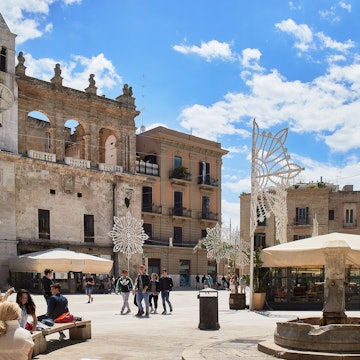

Walking is a great way to see the sites in Puglia. Martina De Pascali for Lonely Planet
Sometimes called the “heel of Italy,” Puglia doesn’t draw as many foreign travelers as other coastal areas of Europe’s playground.
This means that the region remains a treasure trove to discover – from cities with millennia-old history in their walls to breathtaking beaches where all you have to do is relax under the sun.
Cities and towns in Puglia are perfect for exploring on foot – although getting between them and around the wider region may pose logistical challenges. A bit of planning – and this guide to getting around the region – featuring transportation options in Puglia will help make your trip one you’ll never forget. Along with our travel tips for Puglia, make sure to check out our list of best places to visit in Puglia and what to know before you go.

Explore Puglia’s cities on foot
If you’re exploring Bari, Taranto, Lecce or other cities in the region, count on getting around on foot. Walking spares you the stress of driving in Puglia through narrow streets and finding parking. And a leisurely stroll lets you take your time to explore all there is to see, from Taranto’s Castello Aragonese to the picturesque streets of Bari Vecchia.
Remember to pack water and sunscreen if you’re visiting during the height of summer; the heat can be significant, especially in the midst of the marble and stones of historic city centers. Most Italians cope by avoiding going out during the hottest hours of the day – so don’t be surprised if you don’t see many people out between noon and 4pm.

Renting a car is the best way to explore Puglia
The best way to explore Puglia? By renting a car. While this is never the cheapest transport option, having your own car means you can travel at your own pace and make your own schedule – including as many stops as you’d like along the way, for anything that catches your fancy. Your own ride spares you from relying on public transport, which is present throughout the region but can be difficult to navigate.
You can rent a car in most of the major cities. Still, road tripping around Puglia isn’t totally carefree. Road surfaces might not be top-notch in many areas, and you’ll find that road signage is often not as regular or clear as it could be. Keep an eye out for Google Maps indications, and allow time for the possibility of taking a wrong turn.
The biggest headache? Driving and parking in cities and villages. You’ll find many limited-traffic zones (ZTL for short) where only residents can enter or park. Keep an eye out for the ZTL signs, which are rectangular and white with a red circle and “Zona a traffico limitato” in black type.

Navigating Puglia’s trains and buses
If you’re not fond of driving or want to keep your trip as eco-friendly as possible, then opt for public transportation in Puglia, which means both trains and buses. When it comes to trains, your best option is checking out the Trenitalia app, where you can plan routes, consult timetables and buy tickets. The last feature comes in handy, because many smaller stations no longer have working ticket offices.
If you can’t find a ticket office and don’t have the app, then your best bet for pre-buying a ticket (and avoiding the surcharge for onboard purchases) is a local tabaccheria (tobacco shop) or edicola (newsstand).
While trains cover routes between major towns and are relatively reliable – as much as trains in Italy can be… – buses offer service to smaller and more-remote places. Yet bus timetables are quite difficult to navigate, and service is often subject to delays, which means you’ll need to be as flexible as you can if you choose this means of transportation. Keep in mind that bus schedules are usually geared toward commuters and students rather than tourists, and that packing light for buses is always a good idea.

Slow down your travel by cycling
Taking it slow by getting around on a bicycle offers a unique way to experience all that Puglia has in store. Cycling is especially lovely during shoulder season, when the weather is milder, and spending hours outside becomes pleasant rather than a sweat fest.
As for cycling routes in Puglia, major cities have marked bike lanes – even though sharing the road with auto drivers requires you to stay vigilant. Puglia is also crisscrossed by a series of bike routes, like the EuroVelo 5, which follows the ancient Roman Via Appia and connects Taranto to Brindisi on the Adriatic Sea. Another route, the Ciclovia dell’Acquedotto, runs from Cisternino to Ceglie Messapica.
Accessible transportation in Puglia
Sadly, accommodations for accessible travel are not always consistently available in Puglia. Some buses and taxis are wheelchair-accessible – but not all of them, nor are their respective stops. If you’re moving around by train, you can request assistance in advance (via mail, phone or in person) through the national railway system’s Sala Blu service.
















